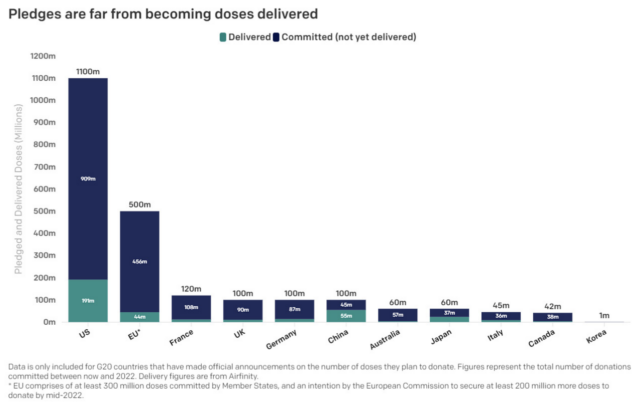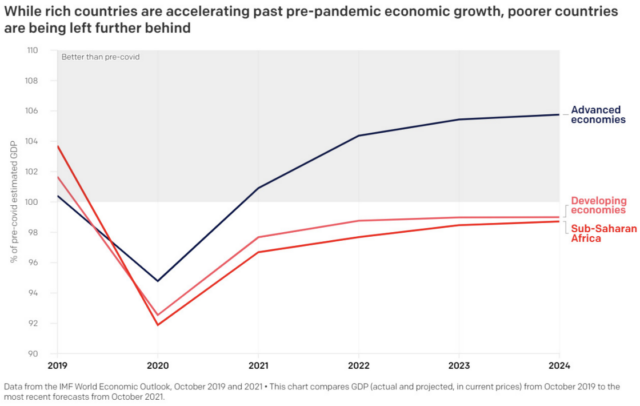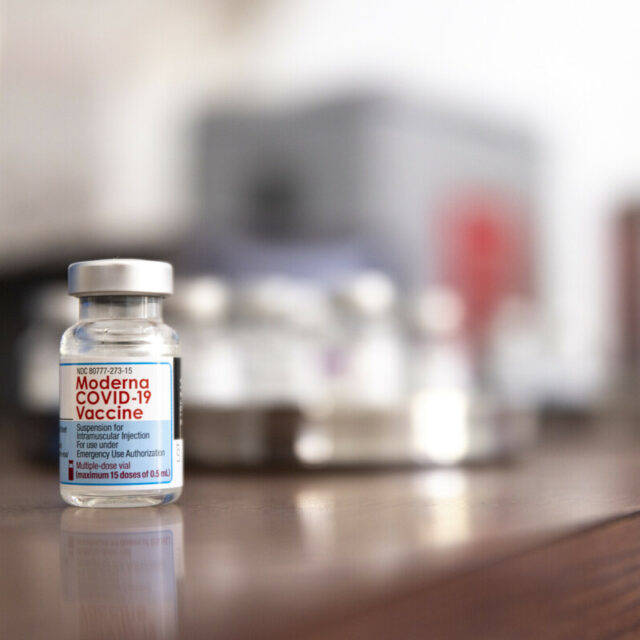It‘s in all our interests to end the pandemic and the economic crisis it continues to drive. We have the means to do this, so what are the issues standing between us and finally ending the pandemic?
1. Wealthy countries are still hoarding vaccines despite nearly meeting the global vaccination target
Did you know? New analysis from ONE shows that twice as many people in wealthier countries have received a booster shot as people in low-income countries got their first vaccine dose. If current trends continue, it could take over a decade before low-income countries achieve vaccination levels similar to high-income countries.
What do we need from G20 countries? Boosters are important, but G20 countries must prioritize first and second doses for the people who need vaccines most, starting with health and key workers and the most vulnerable people in low-income countries. These boosters in high-income countries must not come at the expense of sharing doses that have already been committed to low- and lower-middle-income countries. They also must partner with COVAX and AVATT to ensure doses purchased can be delivered.

2. Vaccine deliveries and schedules are unreliable and unpredictable
Did you know? Vaccine delivery schedules are considered proprietary information making it impossible to hold companies accountable. Vaccines just arrive when they arrive. G20 countries are starting to point to this as a reason for why they haven‘t shared the doses they promise. Even though the G20 countries have committed to sharing at least 657 million doses by the end of 2021, only 293 million have been delivered, and it‘s not clear if or when these commitments will be fulfilled.

What do we need from G20 countries? This lack of predictability leads to vaccines being wasted and fewer people being protected. G20 countries who committed to dose sharing should release a detailed plan for when they plan to fulfil these commitments, the type of vaccines shared, the delivery date and the intended recipient. All doses that are reallocated should go to low and lower-middle-income countries. That‘s not all. For at least the next 12 months, companies should also publicly publish monthly production projections and delivery schedules to help countries better plan and share doses.
3. Low-income countries are still struggling to purchase vaccines as wealthy countries continue to call dibs
Did you know? Since the start of the pandemic, high-income countries had a 6 month start on purchasing doses while slow-walking funding for COVAX because pharmaceutical companies gave them first dibs on the global supply. As a result, they‘ve purchased 32 times more doses than the African Union‘s COVID-19 Africa Vaccine Acquisition Task Team, even though they are both serving populations similar in size!

What do we need from G20 countries? An additional $20 billion is needed in 2022 to reach the 70% vaccine target in every country group and save lives now. We need G20 countries and donors to commit to this – i.e. deliver on the promise, stop hoarding vaccines and fund these commitments.
4. Vaccine manufacturing is only concentrated in a few places globally
Did you know? Global vaccine production is concentrated in wealthier countries, and companies – like Moderna – are refusing to share their recipe or technology to help scale up global production. As a result, without more knowledge sharing alongside more localized production, low-income countries are stuck and dependent on a broken vaccine market and increasingly volatile global supply chains.

What do we need from G20 countries? G20 countries should invest in regional manufacturing, and encourage mRNA manufacturers to share technology with the WHO and local manufacturers, as well as temporarily waive intellectual property rights at the WTO.
5. The global economic recovery is at risk as wealthy countries continue to hoard resources
Did you know? The pandemic has caused the first rise in extreme poverty in 2 decades; 2020 saw almost 100 million more people pushed into extreme poverty. Wealthy countries could spend trillions protecting their economies and are getting back to normal, while poorer countries will see years of slowdown. The $650 billion of Special Drawing Rights (SDRs) were created to help vulnerable countries to respond to the economic impact of the pandemic but some wealthy countries are still hoarding this windfall.

What do we need from the G20 countries? Advanced economies must recycle their allocations of SDRs, which are currently lying unused, to low- and vulnerable middle-income countries. The G7 promised to deliver $100 billion in recycled SDRs and this is a commitment that must be met, with a clear roadmap to recycling more next year.



